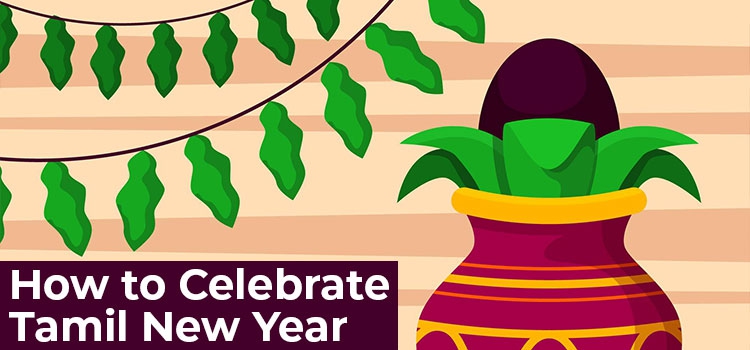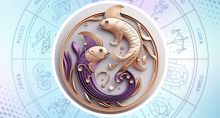How to Celebrate Tamil New Year
Tamil New Year marks the beginning of Chithirai, the first month of the Tamil calendar, for Tamilians. It is popularly called Puthandu or Puthu Varudam. It signifies the first day of Chithirai.
It is a very auspicious day and signifies new beginnings, new dreams, and opportunities. Puthandu falls invariably on April 14th, according to the Western calendar.
Tamilians celebrate the New Year with greetings extended to family, relatives, friends, and neighbors. They offer greetings to each other, saying "Puthandu Vaazhthugal" or "Iniya Puthandu Nalvaazhthugal." This means 'Happy Tamil New Year.' The Tamil New Year 2021 falls on Wednesday, April 14th.
It is a day spent with the family. Celebrations begin by cleaning one's home. The whole house is cleaned and made tidy in preparation for the festive day. Some people clean the house the previous day, while others do the cleaning on the festival day.

People start the day by taking a cleansing bath. Many people opt for a herbal bath. Women normally take a turmeric bath. On this festive occasion, people wear new clothes, which is a tradition. It augurs new beginnings. People mostly opt for traditional and ethnic wear on this day.
The doorway is traditionally adorned with mango leaves. The mango tree is believed to be auspicious according to religious belief. It signifies purity and freshness. Besides, plucking leaves from the mango tree helps the tree grow, as it comes to fruition in the summer months.
People draw beautiful and exquisitely designed 'Kolams' with Kolamaavu (ground rice powder) on their front porches or outside their doorways. They also use colorful rice flour to add delightful variations to the visual aspect. They place a traditional lamp called the 'Kuthu Vilakku' at the center of the Kolam. The lamp is lit and signifies light and dispels darkness.
Festive dishes are prepared, and condiments are purchased ahead of the festive day. A tradition is followed in the preparation of food. It is called 'Arusuvai,' meaning six different tastes that mark Tamil cuisine. It is represented by sweet, salty, bitter, sour, spicy, and a taste defined as 'Thuvarpu.' It denotes the taste of a betelnut leaf, normally consumed after a meal, which carries the taste of the Indian gooseberry.
People prepare traditional dishes for the festive day. The sweet Payasam (kheer made with milk), and Vada (made of lentils), besides Pachadi (mango based in yogurt), are mandatory. The 'Mukkani' signifies three fruits – mango, jackfruit, and banana, which are added to the festival's meals.
The family performs the pooja. Prayers are offered to the deities for blessings. Deities are beautifully decorated with garlands. Flowers are offered in the pooja along with prayers for auspicious and new beginnings. The food offerings include fruits and sweets.
They light lamps, incense sticks, and saambrani as part of the ritual. Sacred mantras are chanted, and Aarti is offered to the deities with the ringing of the sacred bell. Devotional songs are also sung. The elder of the family reads from the Panchangam, a Hindu Vedic calendar that keeps the important dates and auspicious timings, with family members gathered around.
Families usually visit the nearby temple and offer prayers, seeking the blessings for a good year ahead, growth and prosperity. People break coconuts which hold an important significance in Hindu tradition. They are mostly offered to Ganesha, the God of new beginnings, called Vignahartha - the remover of obstacles. This tradition is a symbol of hope and good fortune for the year ahead. The head priest in the temple reads the Panchagam (Hindu calendar).
People set out to visit relatives and friends, carrying sweets and other delicacies to be exchanged amidst greetings. Families sit down to an elaborate feast. Only vegetarian food is made on this auspicious day. Some people offer a special dish called Pongal on this day. The main component in this vast spread is the Mango Pachadi, with its numerous flavors signifying the different periods or stages of life.
In Kerala, it is celebrated as Vishu, in Odisha as Pana Sankranti, in West Bengal as Poila Boishak, in Assam as Bihu, and in Punjab as Baishaki. Tamil New Year is celebrated across Tamil Nadu and the Tamil diaspora in other countries, including Sri Lanka, Malaysia, Singapore, Mauritius, and other countries.
On this auspicious day, a big car festival is celebrated at Tiruvidaimarudur, near Kumbakonam. The car festivals are also held in Kanchipuram, Tiruchirapalli, and other places. In the Madurai Meenakshi Temple, a huge exhibition called Chithirai Porutkaatchi is held.
Tamil New Year augurs a new beginning, of new hopes and opportunities, of wellbeing, and prosperity. It is a time to rejoice, celebrate new beginnings, pray, eat, and come together as a family and community.




















